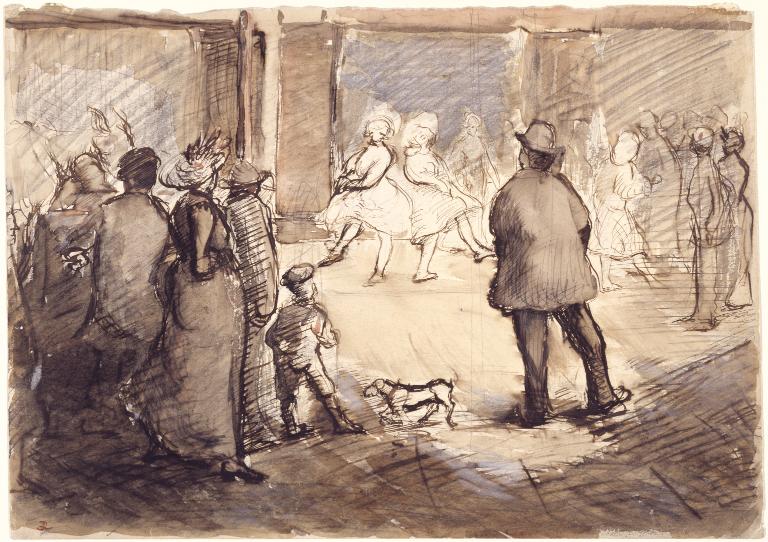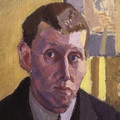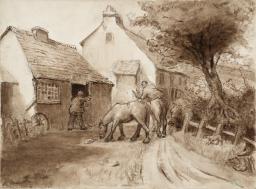Spencer Gore Dancing in the Street c.1904
Spencer Gore,
Dancing in the Street
c.1904
Gore’s watercolour, executed in a limited palette of monochrome browns, establishes its spatiality by using light lines in the distance and stronger or darker strokes in the foreground. Vigorous pen lines suggest he may have begun drawing on location, depicting the lively dancing of two working class women to the music of a barrel organ.
Spencer Gore 1878–1914
Dancing in the Street
c.1904
Graphite, ink and watercolour on paper
251 x 355 mm
Inscribed by ?Albert Rutherston ‘Drawing by F. Spencer Gore | Given to Albert Rutherston 1904 | The figure in hat on the right is meant to be Albert R.’ in red ink on back; stamped ‘AR’ monogram in red ink bottom left, the collection stamp of Albert Rutherston.
Presented by Albert Rutherston 1941
N05307
c.1904
Graphite, ink and watercolour on paper
251 x 355 mm
Inscribed by ?Albert Rutherston ‘Drawing by F. Spencer Gore | Given to Albert Rutherston 1904 | The figure in hat on the right is meant to be Albert R.’ in red ink on back; stamped ‘AR’ monogram in red ink bottom left, the collection stamp of Albert Rutherston.
Presented by Albert Rutherston 1941
N05307
Ownership history
Given by the artist in 1904 to Albert Rutherston (1881–1953), by whom presented to Tate Gallery 1941.
Exhibition history
1992–3
Beardsley to Bomberg: British Drawings and Watercolours 1870–1920, Tate Gallery, London, November 1992–February 1993 (no number, reproduced in broadsheet).
References
1964
Mary Chamot, Dennis Farr and Martin Butlin, Tate Gallery Catalogues: The Modern British Paintings, Drawings and Sculpture, vol.1, London 1964, p.247.
1980
Simon Watney, English Post-Impressionism, London 1980, p.38, reproduced fig.12.
Technique and condition
Dancing in the Street is executed in graphite, ink and watercolour on off-white wove paper. The paper is medium weight and of good quality. The sheet has three cut edges but the top edge is torn, suggesting that it is a page taken from a sketchbook. The artists’ colourmen Percy Young and John Bryce Smith are both known to have supplied Gore with sketchbooks.1 The drawing covers the extent of the sheet. It is executed in soft pencil, iron gall ink and thin watercolour washes. An opaque white has been applied thinly in places to provide highlights. The surface of the paper has been scratched away at the dancer’s feet and in the skirt of the woman on the left, to readjust the position of the foot and the line of the skirt. The iron gall ink has bled into the watercolour when it was applied and has begun to ‘burn’ through the paper where lines have been reinstated. The outlines of the figures are now clearly visible on the reverse of the sheet.
The palette is limited and dominated by dark brown monochrome washes. Colour is used sparingly with blue and red used in the background to reinforce perspective and in the foreground as unifying highlights, creating a convincing sense of space. This is reinforced by the variation in the strength of the line in relation to the spatial position of the form. This technique was used by Gore to enhance the sense of light and space in his drawings: ‘use lighter lines for things father [sic] off and stronger for those near to, and the more closely you observe these kinds of relation the more likely you are to get the look of sunshine etc into your drawings’.2
Tomoko Kawamura and Sarah Morgan
June 2005
Notes
How to cite
Tomoko Kawamura and Sarah Morgan, 'Technique and Condition', June 2005, in Robert Upstone, ‘Dancing in the Street c.1904 by Spencer Gore’, catalogue entry, May 2009, in Helena Bonett, Ysanne Holt, Jennifer Mundy (eds.), The Camden Town Group in Context, Tate Research Publication, May 2012, https://wwwEntry
The back of this drawing is inscribed in red ink, probably by Albert Rutherston: ‘Drawing by F. Spencer Gore | Given to Albert Rutherston 1904 | The figure in hat on the right is meant to be Albert R.’ But Rutherston’s famously diminutive stature seems to make this identification somewhat unlikely, as the man in the hat is evidently taller than the figures on the left of the composition. On the back of the drawing is another inscription in pencil, ‘Gore (a Rutherston)’, probably made by Spencer Gore himself. The drawing was never used to form the basis of an oil painting, as many of Gore’s later drawings did, but is instead complete and independent in itself. The title was not Gore’s own. On 14 October 1941, Rutherston wrote to the director of the Tate Gallery, his nephew John Rothenstein, ‘Give the Gore drawing any title you choose, “Street Scene”, “Street Dancers?”’1
The vigour of the pen and ink lines and the way in which the figures are freely sketched suggest that Gore might have started this drawing on the spot. The man on the left is playing a barrel organ, and the dancers may either be part of his busking act or, more likely perhaps, women who have spontaneously started to dance. Gore was of course an enthusiastic sketcher of dance in the theatre, but this street scene is perhaps the earliest evidence of his growing interest in outdoor urban observation. This is a scene of working class entertainment, adding a frisson of naturalist surveillance to Gore’s act of drawing. The dancing women’s raised skirts revealing their legs would, even in 1904, still have transgressed boundaries of middle class probity. Such spontaneity, vitality and lack of concern for social convention were attributes of a long-standing stereotypical view of working class life and culture. In the popular imagination, London cockneys were portrayed as cheerful, indefatigable and nearly always game for singing or dancing.

William Orpen 1878–1931
Improvisation on a Barrel Organ 1904
Oil paint on canvas
110 x 153 cm
Walker Art Gallery, Liverpool
Photo © National Museums Liverpool
Fig.1
William Orpen
Improvisation on a Barrel Organ 1904
Walker Art Gallery, Liverpool
Photo © National Museums Liverpool
This drawing dates from around 1904, the year Rutherston and Gore made a painting expedition to Cany in France. Rutherston had first met Walter Sickert in 1900 with Max Beerbohm and Reggie Turner while he was on his way to Cany to meet up with his brother William Rothenstein, Augustus John and Orpen. On this 1904 trip, Rutherston suggested that he and Gore visit Dieppe so that his friend would have the opportunity to meet Sickert.2 It became part of the self-mythology of Sickert’s life that this encounter precipitated his return to the London art scene.3 Gore spoke enthusiastically of a new generation of young painters. Impressed by Gore, Sickert seems to have judged it an opportune moment to rejoin the fray of the London avant-garde, and saw an opportunity to become the focus of a group of younger artists.
Albeit at a later date than the drawings in the Tate collection, Gore’s attitude towards draughtsmanship was made clear in his correspondence with his pupil John Doman Turner from 1908 to 1913. Doman Turner was deaf, and Gore undertook to teach him drawing by correspondence, a sequence that totals forty-two letters. He stressed to Doman Turner that ‘A drawing is an explanation of an observation’, and advised cultivating a certain detachment from the subject itself while working: ‘I have always had too great an admiration for Victoria Monks to be able to make a decent drawing of her. One is liable to be too particular. You must forget that she interests you at all while you draw her.’4 In his first letter, dated 8 June 1908, Gore advised Doman Turner to ‘draw anything that interests you’;5 in the second, on 26 June, he described his recommended way of drawing:
It is much better to start in the middle of a bit of paper and let your drawing grow out to each side as far as it wants to ... A drawing should grow like a plant grows, gradually, round one point. Don’t think about making patterns but of drawing objects in such a way that a sculptor could model from them; to represent the length depth and breadth of an object or a series of objects as if you were passing your hand over them and had understood them by touch and not only by sight.
Contour and light and shade have no value of themselves, it does not matter whether the lines are clumsy and the shadow ragged so long they both help to explain the size and shape of some form in relation to the other forms which go to make up the object or objects that you are drawing.6
On 8 September Gore wrote ‘Nearly everything I have told you comes through Walter Sickert from Degas, Sickert is one of the few persons who knows Degas really well’.7
Robert Upstone
May 2009
Notes
Related biographies
Related catalogue entries
Related reviews and articles
- Albert Rutherston, ‘From Orpen and Gore to the Camden Town Group’ The Burlington Magazine, vol.83, no.485, August 1943, pp.201–5.
How to cite
Robert Upstone, ‘Dancing in the Street c.1904 by Spencer Gore’, catalogue entry, May 2009, in Helena Bonett, Ysanne Holt, Jennifer Mundy (eds.), The Camden Town Group in Context, Tate Research Publication, May 2012, https://www





